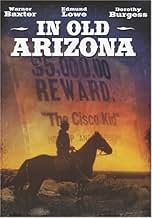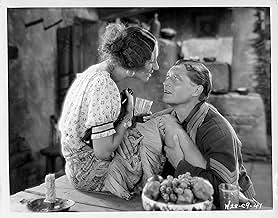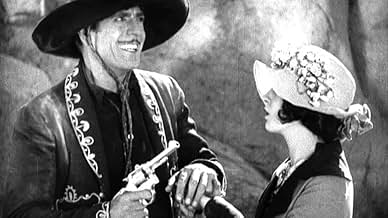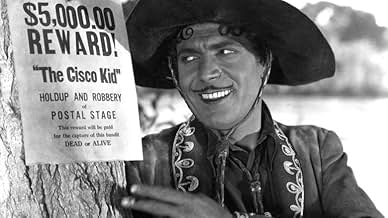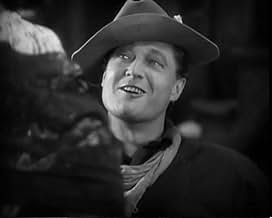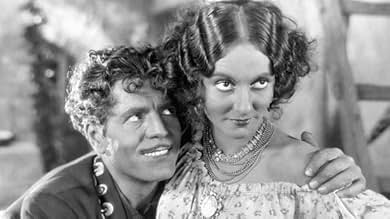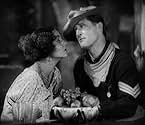VALUTAZIONE IMDb
5,5/10
1431
LA TUA VALUTAZIONE
Aggiungi una trama nella tua linguaA charming, happy-go-lucky bandit in old Arizona plays cat-and-mouse with the sheriff trying to catch him while he romances a local beauty.A charming, happy-go-lucky bandit in old Arizona plays cat-and-mouse with the sheriff trying to catch him while he romances a local beauty.A charming, happy-go-lucky bandit in old Arizona plays cat-and-mouse with the sheriff trying to catch him while he romances a local beauty.
- Regia
- Sceneggiatura
- Star
- Vincitore di 1 Oscar
- 4 vittorie e 4 candidature totali
Henry Armetta
- Barber
- (non citato nei titoli originali)
James Bradbury Jr.
- Soldier
- (non citato nei titoli originali)
Frank Campeau
- Man Chasing Cisco
- (non citato nei titoli originali)
John Webb Dillion
- Second Soldier
- (non citato nei titoli originali)
Alphonse Ethier
- Sheriff
- (non citato nei titoli originali)
Jim Farley
- Townsman
- (non citato nei titoli originali)
William Gillis
- Guard
- (non citato nei titoli originali)
Pat Hartigan
- Cowpuncher
- (non citato nei titoli originali)
Soledad Jiménez
- Tonita the Cook
- (non citato nei titoli originali)
Ivan Linow
- Russian Immigrant
- (non citato nei titoli originali)
Tom London
- Man in Saloon
- (non citato nei titoli originali)
Helen Lynch
- Stagecoach Passenger
- (non citato nei titoli originali)
J. Farrell MacDonald
- Stage Passenger
- (non citato nei titoli originali)
Julius Viggo Madsen
- Tenor in Quartet
- (non citato nei titoli originali)
Recensioni in evidenza
Despite the desert setting and saloons and the presence of a Mexican bandit, cavalry officers and senoritas, this is really an exotic romantic drama (based on a story by the renowned O. Henry) as opposed to a straight Western. Being an early Talkie, it's obviously creaky with very dated acting but retains plenty of interest for the non-casual film-buff even after all these years: for one thing, it basically served as a template for the myriad Westerns that followed involving the exploits of some famous bandit or other (beginning with King Vidor's BILLY THE KID [1930]); besides, the flirtatious character of Dorothy Burgess may well have inspired Linda Darnell's Chihuahua in John Ford's classic MY DARLING CLEMENTINE (1946) nearly twenty years later!
Warner Baxter was a popular star of the era who has been largely neglected over the years; his Oscar-winning performance here isn't bad, but seems hardly outstanding at this juncture his talent is more readily evident, in fact, in such later films as 42ND STREET (1933) and John Ford's THE PRISONER OF SHARK ISLAND (1936). The same can be said of Edmund Lowe: if he's at all remembered today, it's for his "Quirt & Flagg" series of war films with Victor McLaglen (three of them helmed by this film's original director, Raoul Walsh), the Bela Lugosi vehicle CHANDU THE MAGICIAN (1932; in the title role), and the noir-ish gangster drama DILLINGER (1945). While his character curiously speaks in modern i.e. 1920s slang, he interacts well with both Baxter and Burgess especially effective is the scene where he comes face to face with Baxter's Cisco Kid at a barber shop and, ignorant of the latter's identity, lets him slip away.
The film features a couple of songs (one of them, by the famed songwriting trio of DeSylva-Brown-Henderson, is heard several times throughout and even serves as an Overture to the feature proper) and archaic comedy relief by a number of minor characters notably Burgess' long-suffering elderly maid. There's far more talk than action here, but the twist ending (subsequently much copied) is remarkable if anything, because it's unexpectedly pitiless for a film of its era! Incidentally, the lead role was to have been played by Raoul Walsh himself but he was injured (eventually losing an eye) in a driving accident; Irving Cummings replaced him behind the cameras (and, oddly enough, alone received the Best Director nomination, despite Walsh's name still appearing in the credits)!
P.S. Baxter, Lowe and director Cummings were re-united shortly after for a sequel THE CISCO KID (1930); one wonders whether copies of the film still exist as, ideally, it should have been paired with the original on the bare-bones Fox DVD...
Warner Baxter was a popular star of the era who has been largely neglected over the years; his Oscar-winning performance here isn't bad, but seems hardly outstanding at this juncture his talent is more readily evident, in fact, in such later films as 42ND STREET (1933) and John Ford's THE PRISONER OF SHARK ISLAND (1936). The same can be said of Edmund Lowe: if he's at all remembered today, it's for his "Quirt & Flagg" series of war films with Victor McLaglen (three of them helmed by this film's original director, Raoul Walsh), the Bela Lugosi vehicle CHANDU THE MAGICIAN (1932; in the title role), and the noir-ish gangster drama DILLINGER (1945). While his character curiously speaks in modern i.e. 1920s slang, he interacts well with both Baxter and Burgess especially effective is the scene where he comes face to face with Baxter's Cisco Kid at a barber shop and, ignorant of the latter's identity, lets him slip away.
The film features a couple of songs (one of them, by the famed songwriting trio of DeSylva-Brown-Henderson, is heard several times throughout and even serves as an Overture to the feature proper) and archaic comedy relief by a number of minor characters notably Burgess' long-suffering elderly maid. There's far more talk than action here, but the twist ending (subsequently much copied) is remarkable if anything, because it's unexpectedly pitiless for a film of its era! Incidentally, the lead role was to have been played by Raoul Walsh himself but he was injured (eventually losing an eye) in a driving accident; Irving Cummings replaced him behind the cameras (and, oddly enough, alone received the Best Director nomination, despite Walsh's name still appearing in the credits)!
P.S. Baxter, Lowe and director Cummings were re-united shortly after for a sequel THE CISCO KID (1930); one wonders whether copies of the film still exist as, ideally, it should have been paired with the original on the bare-bones Fox DVD...
Although this film was released in January 1929, it was filmed in 1928. That makes it truly amazing when you think that the first all-talking picture wasn't even released until July 1928 - "Lights of New York". As others have mentioned, this film does not have lots of action - much screen time is spent with characters just talking in specific locations. There are no exciting shoot-outs or chases as you would expect in a western made just five years later. This is probably due to the motion constraint of the early sound cameras. However, you do get some tremendous long shots of some stunning western vistas. This was because Fox was an early adopter of sound-on-film versus sound-on-disc. This gave Fox the ability to shoot outside and made the studio an innovator in the production of newsreels - they could take their cameras anywhere.
As for the film itself, I'd recommend it only if you're interested in early sound films. Otherwise, you'll probably be bored stiff due to the lack of action. Warner Baxter's portrayal of the Cisco Kid is quite good. He doesn't get too campy with a role that could have been over-the-top in the wrong hands. I do have to wonder - why is every single member of the army that is pursuing Cisco speaking with a Queens accent and why are they using urban New York slang? Was there a mix-up at central casting that day? Was the cast of this film supposed to show up for a Bowery Boys film or a gangster picture and wound up here by mistake? In 1928 there were dialogue coaches, but probably not many coaches on regional dialect. It's a shame to think that if John Wayne had tried out for this early sound western he would have been turned down because he didn't sound like he was from Brooklyn.
As for the film itself, I'd recommend it only if you're interested in early sound films. Otherwise, you'll probably be bored stiff due to the lack of action. Warner Baxter's portrayal of the Cisco Kid is quite good. He doesn't get too campy with a role that could have been over-the-top in the wrong hands. I do have to wonder - why is every single member of the army that is pursuing Cisco speaking with a Queens accent and why are they using urban New York slang? Was there a mix-up at central casting that day? Was the cast of this film supposed to show up for a Bowery Boys film or a gangster picture and wound up here by mistake? In 1928 there were dialogue coaches, but probably not many coaches on regional dialect. It's a shame to think that if John Wayne had tried out for this early sound western he would have been turned down because he didn't sound like he was from Brooklyn.
It was so enjoyable going way back in time to the Year 1928 and view Warner Baxter,(The Cisco Kid) who played his role the way I would want to see an actor portray The Cisco Kid. Dorothy Burgess, (Tonia Maria) is the girl friend of Cisco Kid and gives a great supporting role as a gold digger who wants plenty of gold, romance and any man who desires her charm. Edmund Lowe, (Sergeant Mickey Dunn) plays a soldier who is hunting down the Cisco Kid and gets himself involved with Tonia Maria in order to set up a trap to catch the Cisco Kid. Sgt.Mickey Dunn is from New York and talks and sings about the Bowery and brags about the cost of a beer for only five (5) cents and all the food you can eat. It is nice to know that Warner Baxter won an Oscar for his performance as the Cisco Kid, who was also the star of many "Crime Doctor" films as Dr. Ordway. This is a great classic film that you will not want to miss from 1928 and also has sound for the voices. Enjoy
I have heard so much about In Old Arizona that I truly was anticipating a genuine 'western' experience since this was a Fox film . I know the production values and story lines in their silents were always entertaining . I kept waiting for a western but it never came .
One has to be able to be able to imagine the newness of sound to comprehend the audience reaction to this film at its release . The frying bacon scene has been recounted in several different publications . The newness of sound was evident throughout the picture with songs , continual dialogue (sometimes very inane ) , sound effects ,etc. The film tried to overload the senses of the viewers with sound that seemed to come in waves to awe the viewers.
The direction receiving an Academy nomination escapes me completely . It appeared the director knew it was sound , but used tried and true 'silent ' techniques . The constant smiling , grinning and bon vivant attitude of Baxter was reminiscent of second tier silent western stars ala Buddy Roosevely , Wally Wales ,Bill Cody , Bob Custer et al. They all used this carefree , devil-may care attitude constantly .
Probably the most noticeable 'throwback ' methods were the exchange between Baxter and Burgess at the end . Both had a double meaning for their phrases which could have translated into a very delightful scene . However both of them resorted to 'silent' facial expressions that let the audience in on the meaning , but not the other character . Cummings showed his lack of knowledge and faith in sound as well as subtlety in expressions , but it understandable given his background and the newness of sound.
Baxter handled himself very well , yet you wonder if the Oscar was for the sound element tied to his performance rather than the strength of his acting alone . He always did a creditable job in any picture . Burgess is another story . Her attempt to portray herself as a Hispanic vamp left a lot to be desired . Still you cannot help but see the definite ' borrowing ' for Pearl Chavez in Duel in the Sun . There is no mistaking the copy that Jones used .
Finally , the O. Henry ending for the film was a little different . You reap what you sow is very prevalent in Edmund Lowe and Burgess . They sowed deceit and reaped their just desserts . However , Baxter just goes on his outlaw ways with no consequences . He admits it will come one day for him, but we don't see it . So there is morality and amorality . Where there is no dialogue , I was fascinated how some outdoor scenes took on a John Ford Monument Valley look .
The scene where Burgess goes into the saloon to meet Lowe is priceless . She walks in and she and a customer start exchanging ' let's do business ' glances . Then she meets Lowe and begins to condemn the women who work there and castigates Lowe for comparing her to them . Her self-righteous air is her best piece of acting in the entire movie.
You knew this was precode with some of the dialogue . When Baxter tells Lowe he is known as " Conejito " , Lowe 's line asking ' is he that fast' is priceless . The allusions abound .
Still this is well worth the time to view . First for the historical as to the use of sound . Then there is the introduction of the Cisco Kid . You have to have this film to trace the evolution of the character in film . When Baxter was talking about Yaqui being his best friend , you almost expected a pan to Pancho based upon preconditioning to the pair .
The morality and the love triangle dominate this film . There is no issue to be resolved as none ever existed . You have a story of 3 people - interesting , but slow moving and slower developing . Glad I own it and watched it
One has to be able to be able to imagine the newness of sound to comprehend the audience reaction to this film at its release . The frying bacon scene has been recounted in several different publications . The newness of sound was evident throughout the picture with songs , continual dialogue (sometimes very inane ) , sound effects ,etc. The film tried to overload the senses of the viewers with sound that seemed to come in waves to awe the viewers.
The direction receiving an Academy nomination escapes me completely . It appeared the director knew it was sound , but used tried and true 'silent ' techniques . The constant smiling , grinning and bon vivant attitude of Baxter was reminiscent of second tier silent western stars ala Buddy Roosevely , Wally Wales ,Bill Cody , Bob Custer et al. They all used this carefree , devil-may care attitude constantly .
Probably the most noticeable 'throwback ' methods were the exchange between Baxter and Burgess at the end . Both had a double meaning for their phrases which could have translated into a very delightful scene . However both of them resorted to 'silent' facial expressions that let the audience in on the meaning , but not the other character . Cummings showed his lack of knowledge and faith in sound as well as subtlety in expressions , but it understandable given his background and the newness of sound.
Baxter handled himself very well , yet you wonder if the Oscar was for the sound element tied to his performance rather than the strength of his acting alone . He always did a creditable job in any picture . Burgess is another story . Her attempt to portray herself as a Hispanic vamp left a lot to be desired . Still you cannot help but see the definite ' borrowing ' for Pearl Chavez in Duel in the Sun . There is no mistaking the copy that Jones used .
Finally , the O. Henry ending for the film was a little different . You reap what you sow is very prevalent in Edmund Lowe and Burgess . They sowed deceit and reaped their just desserts . However , Baxter just goes on his outlaw ways with no consequences . He admits it will come one day for him, but we don't see it . So there is morality and amorality . Where there is no dialogue , I was fascinated how some outdoor scenes took on a John Ford Monument Valley look .
The scene where Burgess goes into the saloon to meet Lowe is priceless . She walks in and she and a customer start exchanging ' let's do business ' glances . Then she meets Lowe and begins to condemn the women who work there and castigates Lowe for comparing her to them . Her self-righteous air is her best piece of acting in the entire movie.
You knew this was precode with some of the dialogue . When Baxter tells Lowe he is known as " Conejito " , Lowe 's line asking ' is he that fast' is priceless . The allusions abound .
Still this is well worth the time to view . First for the historical as to the use of sound . Then there is the introduction of the Cisco Kid . You have to have this film to trace the evolution of the character in film . When Baxter was talking about Yaqui being his best friend , you almost expected a pan to Pancho based upon preconditioning to the pair .
The morality and the love triangle dominate this film . There is no issue to be resolved as none ever existed . You have a story of 3 people - interesting , but slow moving and slower developing . Glad I own it and watched it
"In Old Arizona" was made in 1928 at a time when sound was still a novelty in films. As such you can see in this film sequences that purely demonstrate sound but add nothing to the story. For example, in the opening scene after the stagecoach leaves, the camera moves to a mariachi band that appears out of nowhere to play a song, and later a scene begins with a quartet warbling a little ditty before moving over to the principle characters.
The story centers on the Cisco Kid (Warner Baxter) who is a likable rogue who robs stagecoaches (but not the passengers) and has a price on his head of $5,000. It seems that everyone knows the kid on sight except the town barber. His girlfriend Tonia Maria (Dorothy Burgess) is an obvious pre-production code prostitute, who "entertains" him when he is not robbing stagecoaches.
The army is asked to do something about all of the robberies. They send Sgt. Mickey Dunn (Edmund Lowe) to investigate. Along the way he meets Tonia Maria who seduces him (off screen of course) and the two plot to capture the Kid and claim the reward. Naturally the Kid uncovers the plot and prepares a surprise for the sergeant and his unfaithful girlfriend.
This film is rather dated when watched today. It is over talkative and has just awful acting in many of the supporting roles, particularly the actor who plays the stagecoach driver. But you have to remember that this was the first year of sound movies. Director Raoul Walsh used outdoor microphones for the first time in a major studio production. You'll notice a few "silent spots" in the out door scenes.
The three leads are OK but the Mexican "accents" of Baxter and Burgess are laughable. Actually as hard to believe as it was, Baxter won the 1929 Academy Award for his role. Walsh was supposed to play the Lowe part but lost an eye in an accident about this time.
J. Farrell MacDonald appears early in the film as an Irish stagecoach passenger.
The story centers on the Cisco Kid (Warner Baxter) who is a likable rogue who robs stagecoaches (but not the passengers) and has a price on his head of $5,000. It seems that everyone knows the kid on sight except the town barber. His girlfriend Tonia Maria (Dorothy Burgess) is an obvious pre-production code prostitute, who "entertains" him when he is not robbing stagecoaches.
The army is asked to do something about all of the robberies. They send Sgt. Mickey Dunn (Edmund Lowe) to investigate. Along the way he meets Tonia Maria who seduces him (off screen of course) and the two plot to capture the Kid and claim the reward. Naturally the Kid uncovers the plot and prepares a surprise for the sergeant and his unfaithful girlfriend.
This film is rather dated when watched today. It is over talkative and has just awful acting in many of the supporting roles, particularly the actor who plays the stagecoach driver. But you have to remember that this was the first year of sound movies. Director Raoul Walsh used outdoor microphones for the first time in a major studio production. You'll notice a few "silent spots" in the out door scenes.
The three leads are OK but the Mexican "accents" of Baxter and Burgess are laughable. Actually as hard to believe as it was, Baxter won the 1929 Academy Award for his role. Walsh was supposed to play the Lowe part but lost an eye in an accident about this time.
J. Farrell MacDonald appears early in the film as an Irish stagecoach passenger.
Lo sapevi?
- QuizThe first all-talking, sound-on-film feature shot outdoors.
- BlooperWhen Cisco robs the stagecoach, he is wearing an army holster (flap-over), the same type the Sergeant wears. But for the rest of the movie, he wears an open holster.
- Citazioni
[last lines]
The Cisco Kid: Her flirting days are over. And she's ready to settle down.
- ConnessioniFeatured in The Soundman (1950)
- Colonne sonoreMy Tonia
Words and Music by Buddy G. DeSylva (as DeSylva), Lew Brown (as Brown) and Ray Henderson (as Henderson)
Sung by Warner Baxter (uncredited)
I più visti
Accedi per valutare e creare un elenco di titoli salvati per ottenere consigli personalizzati
- How long is In Old Arizona?Powered by Alexa
Dettagli
- Data di uscita
- Paese di origine
- Lingue
- Celebre anche come
- In Old Arizona
- Luoghi delle riprese
- San Fernando Valley, Los Angeles, California, Stati Uniti(outdoor riding)
- Azienda produttrice
- Vedi altri crediti dell’azienda su IMDbPro
Botteghino
- Lordo Stati Uniti e Canada
- 2.834.000 USD
- Tempo di esecuzione1 ora 35 minuti
- Colore
Contribuisci a questa pagina
Suggerisci una modifica o aggiungi i contenuti mancanti


